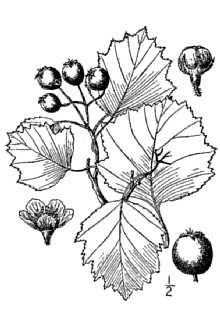Fireberry Hawthorn
Scientific Name: Crataegus chrysocarpa Ashe

| General Information | |
|---|---|
| Usda Symbol | CRCH |
| Group | Dicot |
| Life Cycle | Perennial |
| Growth Habits | ShrubTree, |
| Native Locations | CRCH |
Plant Guide
Alternative Name
round-leaved hawthorn
Uses
Erosion Control: Because it tolerates a wide variety of sites, it can be planted to stabilize banks, for shelterbelts, and from wind and water erosion. Timber: Although the wood is hard and strong, it has no commercial value except for tool handles and other small items. Wildlife: It provides excellent cover and nesting sites for many smaller birds. Birds, rodents and other smaller mammals eat the small fruits. White tailed deer browse the young twigs and leaves. Beautification: Excellent for environmental plantings including small specimen tree, shrub border.
Status
Please consult the Plants Web site and your State Department of Natural Resources for this plant’s current status, such as, state noxious status and wetland indicator values.
Description
from Britton & Brown (1913) by Kentucky Native Plant Society @ PLANTS General: It is a large shrub or tree that grows to twenty feet tall. It is intricately branched and very thorny. Leaves are smooth to hairy, very broad, usually with several shallow lobes, often dull sometimes shiny. Flowers are produced in several clusters. Its nearly rounded fruits are either bright red or yellow. Distribution: Fireberry hawthorn grows from Newfoundland to Pennsylvania and west to the Rocky Mountains.
Adaptation
Although it will succeed in partial shade and different soil types, it grows best in full sunlight, well-drained loamy soils, and will tolerate wet soils becoming drought tolerant once established. It is also wind tolerant making it a good tree species in shelterbelt planting. It is also tolerant of atmospheric pollution and performs well in urban settings.
Establishment
Propagation from Seed or Grafting: Fireberry hawthorn can be propagated by either seeds or grafting. Successful propagation using seeds requires acid scarification followed by warm stratification and prechilling. Seeds, whose numbers per lb. varies with species, are planted early in the fall, in drill rows eight to twelve inches apart and covered with 1/4 inch of soil. Seedlings must not be kept in the nursery longer than a year. Containerized trees should be planted when they are no more than eight feet tall, in the fall or spring. Balled and burlapped trees should be planted in early spring. Grafting on seedling stock of Crataegus oxyacantha or Crataegus monogyna is best carried out in the winter to early spring.
Management
Pruning should be done in the winter or early spring in order to maintain a clear shoot leader on young trees and/or remove the weakest branches to allow more light to pass through. Suckers or stems arising from the roots should be removed when they become noticeable.
Pest and Potential Problems
Although pests and diseases seldom affect it, it is susceptible to fire-blight, cedar-hawthorn rust, cedar-quince rust, leaf blight and fruit rot, and leaf spot, Cultivars, Improved and Selected Materials (and area of origin) Consult you local nurseries to choose the right cultivar for your specific landscape, Contact your local Natural Resources Conservation Service (formerly Soil Conservation Service) office for more information, Look in the phone book under ”United States Government, Use soil moisture sensors to measure the soil moisture of Fireberry Hawthorn.,” The Natural Resources Conservation Service will be listed under the subheading “Department of Agriculture,”
References
Dirr, M.A. 1990. Manual of woody landscape plants: their identification, ornamental characteristics, culture, propagation and uses. 3rd ed. Stipes, Champaign, Illinois. Duncan, W.H. & M.B. Duncan 1988. Trees of the Southeastern United States. University of Georgia Press, Athens, Georgia. Elias, T.S. 1989. Field guide to North American trees. Revised ed. Grolier Book Clubs Inc., Danbury, Connecticut. Flint, H.L. 1983. Landscape plants for eastern North America. John Wiley and Sons, Inc, New York, New York. Harrar, E.S. & J.G. Harrar. 1962. Guide to southern trees. 2nd ed. Dover Publications, Inc., New York, New York. Little, E.E. 1996. National Audubon Society field guide to North American trees: Eastern region. Alfred A. Knopf, New York, New York. USDA Forest Service 1974. Seeds of woody plants in the United States. Agricultural Handbook 450. USDA, Washington, DC. USDA Forest Service 1990. Silvics of North America. Agricultural Handbook 654. Forest Service, USDA, Washington, DC. Young, J. A. & C.G. Young. 1992. Seeds of woody plants in North America. Revised and enlarged ed. Dioscorides Press, Portland, Oregon.
